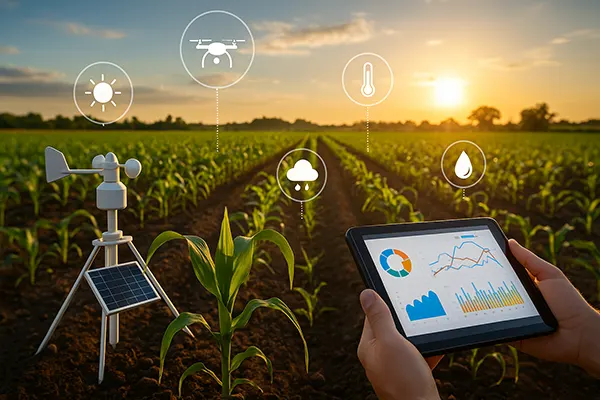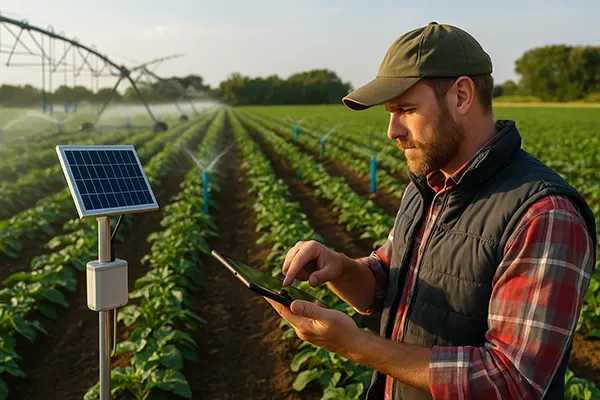Internet of Things (IoT) in Agriculture: The Digital Transformation of Farming

The integration of the Internet of Things (IoT) into modern agriculture has revolutionised the way farms operate. Through smart sensors, automation systems, and real-time data analytics, farmers are now able to make precise, data-driven decisions that enhance productivity, reduce waste, and promote sustainability. As of 2025, IoT technologies are no longer a futuristic concept but an essential component of agricultural management, bridging the gap between traditional farming and digital innovation.
Precision Agriculture and Smart Data Monitoring
IoT devices have introduced precision agriculture — a system where farmers monitor and manage every aspect of their operations using data. Sensors placed across fields collect information on soil moisture, temperature, nutrient levels, and crop health. These insights enable farmers to optimise irrigation schedules and fertiliser use, reducing costs and conserving resources. The outcome is higher yields with minimal environmental impact.
One notable advancement is the use of satellite and drone imaging integrated with IoT networks. These tools provide real-time visualisation of crop conditions, helping to detect pest infestations or water stress early. The data gathered is analysed by AI algorithms that suggest immediate corrective actions. Farmers can access this information via mobile applications, ensuring they stay informed wherever they are.
Additionally, IoT solutions support the traceability of produce. Sensors embedded in packaging monitor temperature and humidity during storage and transport. This transparency strengthens consumer confidence by confirming that food quality is preserved throughout the supply chain, aligning with the growing demand for sustainability and accountability in food production.
Smart Irrigation Systems and Water Management
Water scarcity has become a global concern, making efficient water management vital for agriculture. IoT-enabled irrigation systems respond to real-time soil and weather conditions, delivering water precisely when and where it’s needed. These smart systems prevent overwatering, reduce energy consumption, and help maintain soil fertility by avoiding nutrient runoff.
Farmers in Europe and North America have widely adopted drip irrigation controlled by IoT sensors, which has reduced water use by up to 30%. Moreover, government initiatives in countries like Denmark and the Netherlands encourage the use of IoT for sustainable farming, offering subsidies for installing smart water control systems. These efforts reflect the increasing importance of digital tools in achieving environmental goals.
In addition, predictive analytics powered by IoT networks can forecast droughts or excessive rainfall, allowing farmers to plan in advance. By anticipating climatic changes, they can make informed decisions that safeguard both their crops and financial stability.
Automation and Robotics in Modern Farming
IoT technologies serve as the backbone of agricultural automation. Autonomous tractors, drones, and harvesters now operate using interconnected systems that communicate in real time. This reduces human labour requirements and increases operational efficiency, especially in large-scale farming enterprises. The combination of IoT and robotics has paved the way for continuous, round-the-clock farm management.
Livestock monitoring is another area transformed by IoT. Smart collars and biometric sensors track animal movement, feeding habits, and health conditions. Farmers receive alerts if abnormal patterns are detected, enabling early intervention and preventing disease spread. Such systems have proven particularly effective in dairy production, where maintaining animal welfare directly impacts milk quality and yield.
Greenhouses equipped with IoT sensors also benefit from automated temperature, lighting, and humidity control. These intelligent environments optimise crop growth conditions, increase output, and minimise resource use. In 2025, vertical farms across Europe and Asia are leveraging IoT automation to produce fresh vegetables closer to urban areas, reducing transportation costs and carbon emissions.
Artificial Intelligence and Predictive Farming
The integration of IoT with artificial intelligence has made predictive farming a reality. AI algorithms process data collected from IoT sensors, identifying trends that guide planting schedules, fertiliser applications, and pest control. By analysing historical and real-time information, farmers can predict yield outcomes and optimise their operations for maximum efficiency.
Machine learning models are now capable of simulating how crops will respond to varying environmental conditions. This predictive insight enables proactive management, helping farmers mitigate risks caused by unpredictable weather or soil degradation. The result is a more resilient agricultural system that adapts quickly to changes.
Furthermore, AI-driven analytics can predict market trends and consumer demands. Farmers can plan crop cycles based on anticipated price fluctuations, aligning production with market needs. This combination of IoT and AI creates a closed-loop system where every decision is data-backed and economically sound.

Environmental Sustainability and Future Outlook
IoT is playing a crucial role in driving sustainability within agriculture. Smart farming solutions minimise the overuse of water, pesticides, and fertilisers, reducing pollution and protecting biodiversity. Environmental sensors monitor air and soil quality, helping farmers maintain ecological balance and comply with green regulations.
Renewable energy integration is another significant advancement. Many farms now use solar-powered IoT devices, reducing dependency on fossil fuels and lowering operational costs. This shift aligns with global sustainability goals and promotes energy-efficient agriculture that supports long-term food security.
Looking ahead, IoT will continue to evolve through the use of 5G networks, which will enhance data transmission speed and reliability. This will enable more complex and interconnected systems, making precision agriculture even more sophisticated. The future of farming lies in the seamless cooperation between humans, machines, and data — a truly digital ecosystem of sustainable growth.
Challenges and Policy Development
Despite its advantages, IoT adoption in agriculture faces challenges. High installation costs, cybersecurity concerns, and lack of technical knowledge remain obstacles for small and medium-sized farms. Governments and agricultural organisations must therefore invest in training programmes and provide financial incentives to ensure equal access to technology.
Data privacy is another critical issue. As IoT devices collect vast amounts of information, ensuring that farmers maintain control over their data is essential. Transparent data-sharing policies and cybersecurity frameworks will be key to maintaining trust in digital agriculture.
Finally, international cooperation is vital for establishing IoT standards in farming. Collaboration between tech companies, research institutions, and policymakers will help build a unified approach to sustainable agriculture. With proper governance and support, IoT can become a cornerstone of global food security and environmental resilience.


